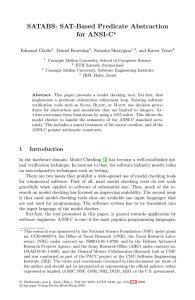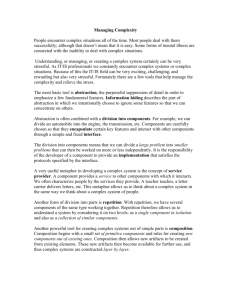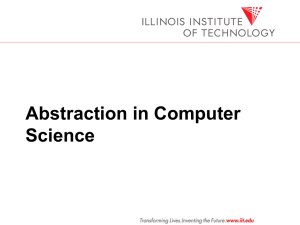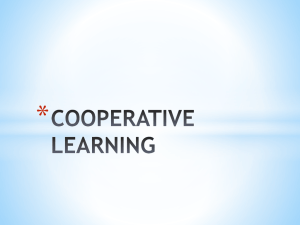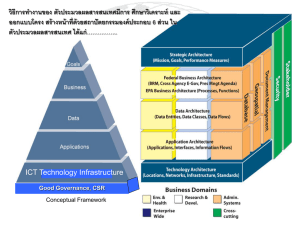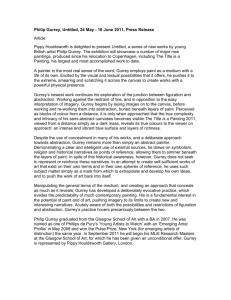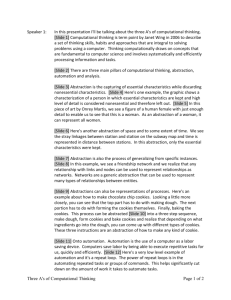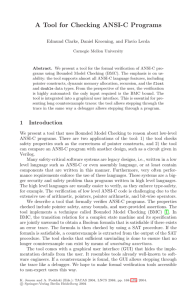SATABS: SAT-based Predicate Abstraction for ANSI-C*
advertisement
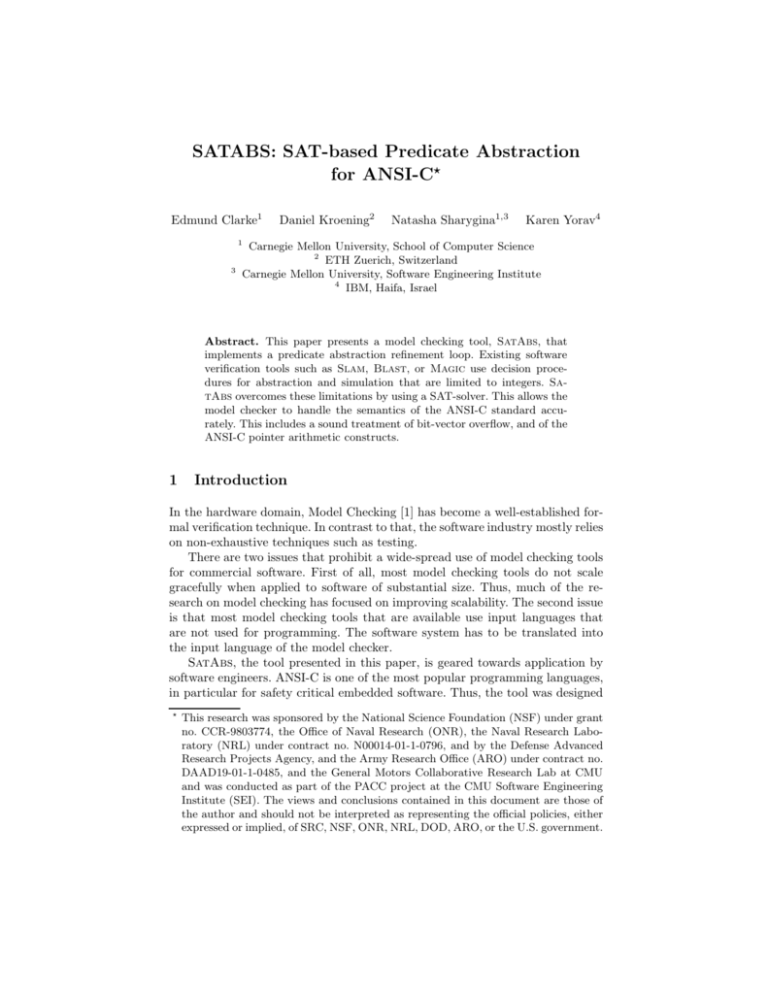
SATABS: SAT-based Predicate Abstraction
for ANSI-C?
Edmund Clarke1
Daniel Kroening2
Natasha Sharygina1,3
Karen Yorav4
1
3
Carnegie Mellon University, School of Computer Science
2
ETH Zuerich, Switzerland
Carnegie Mellon University, Software Engineering Institute
4
IBM, Haifa, Israel
Abstract. This paper presents a model checking tool, SatAbs, that
implements a predicate abstraction refinement loop. Existing software
verification tools such as Slam, Blast, or Magic use decision procedures for abstraction and simulation that are limited to integers. SatAbs overcomes these limitations by using a SAT-solver. This allows the
model checker to handle the semantics of the ANSI-C standard accurately. This includes a sound treatment of bit-vector overflow, and of the
ANSI-C pointer arithmetic constructs.
1
Introduction
In the hardware domain, Model Checking [1] has become a well-established formal verification technique. In contrast to that, the software industry mostly relies
on non-exhaustive techniques such as testing.
There are two issues that prohibit a wide-spread use of model checking tools
for commercial software. First of all, most model checking tools do not scale
gracefully when applied to software of substantial size. Thus, much of the research on model checking has focused on improving scalability. The second issue
is that most model checking tools that are available use input languages that
are not used for programming. The software system has to be translated into
the input language of the model checker.
SatAbs, the tool presented in this paper, is geared towards application by
software engineers. ANSI-C is one of the most popular programming languages,
in particular for safety critical embedded software. Thus, the tool was designed
?
This research was sponsored by the National Science Foundation (NSF) under grant
no. CCR-9803774, the Office of Naval Research (ONR), the Naval Research Laboratory (NRL) under contract no. N00014-01-1-0796, and by the Defense Advanced
Research Projects Agency, and the Army Research Office (ARO) under contract no.
DAAD19-01-1-0485, and the General Motors Collaborative Research Lab at CMU
and was conducted as part of the PACC project at the CMU Software Engineering
Institute (SEI). The views and conclusions contained in this document are those of
the author and should not be interpreted as representing the official policies, either
expressed or implied, of SRC, NSF, ONR, NRL, DOD, ARO, or the U.S. government.
to take ANSI-C programs as input. In SatAbs, a special emphasis was made
on supporting a rich subset of the ANSI-C language. The bit-vector semantics
is modeled accurately, and thus the tool is able to detect errors that are related
to bit-level operators and arithmetic overflow.
In order to address the scalability problem, SatAbs automatically computes an abstraction of the program given as input. Abstraction is one principal
method in state space reduction of software systems. Predicate abstraction [2,
3] is one of the most popular and widely applied methods. It abstracts data
by only keeping track of certain predicates. Each predicate is represented by a
Boolean variable in the abstract model, while the original variables are eliminated. The abstract program is created using Existential Abstraction [4], which
is a conservative abstraction for reachability properties. If the property holds on
the abstract model, it also holds on the original program.
The drawback of the conservative abstraction is that when model checking
of the abstract program fails, it may produce a counterexample that does not
correspond to a concrete counterexample. This is called a spurious counterexample. When a spurious counterexample is encountered, refinement is performed
by adjusting the set of predicates in a way that eliminates this counterexample.
This is automated by Counterexample Guided Abstraction Refinement [5–7].
Related Work. Counterexample guided abstraction refinement for ANSI-C programs was promoted by the success of the Slam project at Microsoft [6]. Thus,
there are already a number of other implementations, such as Magic [8], ComFoRT [9] and Blast [?]. All these projects have support for concurrent software.
Both Slam and Blast now implement forms of lazy abstraction.
The feature that distinguishes SatAbs from these existing tools is the tight
integration of a SAT solver into the abstraction, simulation, and refinement steps
of the abstraction refinement loop. This allows precise encodings of the semantics
of the ANSI-C language, including pointer-arithmetic and bit-vector overflow.
In contrast to that, all the tools mentioned above rely on external theorem
provers to reason about the programming language constructs. Initially, Slam,
Blast, Magic, and ComFoRT used the theorem prover Simplify [10], which
supports linear arithmetic on real numbers only. The remaining operators are
approximated by means of uninterpreted functions. The Slam project replaced
Simplify by Zapato [11], which provides better performance, but no support
for bit-vectors.
The use of propositional logic and a SAT solver to reason about ANSI-C
language constructs is already found in CBMC [12], a Bounded Model Checker
for ANSI-C programs. There is a prototype of Slam, which has been integrated
with parts of CBMC to reason about bit-vector constructs [13]. This version
has found a previously unknown bug in Windows.
In [14], Lahiri, Bryant, and Cook use the SAT-based quantification engine
implemented in SatAbs in order to compute abstractions of C programs. However, the algorithm uses unbounded integer semantics for the program variables,
and does not support bit-vector operators. An integration into a full abstraction
refinement loop is not reported.
In order to make SatAbs applicable to a wide range of low-level programs,
SatAbs supports most constructs found in the ANSI-C language. In particular,
it has support for arrays (with possibly unbounded size), and unions. None of
the tools cited above provides these features. SatAbs is integrated into the
graphical user interface (GUI) of CBMC. The user interface allows the user to
step through counterexample traces generated by SatAbs as if using a debugger.
The GUI is described in more detail in [12].
2
Using SAT for Predicate Abstraction and Refinement
This section provides a short overview of the algorithm implemented by SatAbs. For more information on the algorithm in the case of sequential code, we
refer the reader to [15]. The algorithm is extended to concurrent programs with
asynchronous interleaving semantics in [16].
SatAbs uses SAT-based Boolean quantification in order to compute the
abstract model. Let S denote the set of concrete states, R the concrete transition
relation, and α(x) with x ∈ S the abstraction function. The abstract model can
make a transition from an abstract state x̂ to x̂0 iff there is a transition from x
to x0 in the concrete model and x is abstracted to x̂ and x0 is abstracted to x̂0 .
Formally, the abstract transition relation is denoted by R̂.
R̂ := {(x̂, x̂0 ) | ∃x, x0 ∈ S : R(x, x0 ) ∧ α(x) = x̂ ∧ α(x0 ) = x̂0 }
This formula is transformed into CNF by replacing the bit-vector arithmetic
operators by arithmetic circuits. Due to the quantification over the abstract
states this corresponds to an all-SAT instance. For efficiency, SatAbs overapproximates R̂ by partitioning the predicates into clusters [17].
The abstract model is passed to a model checker. SatAbs support a variety
of model checkers, e.g., Moped, SPIN, NuSMV, and a QBF-based symbolic
simulator. If the model checker returns a counterexample, it has to be simulated
on the original code to check if it is spurious.
Given an abstract error trace, SatAbs first checks if it contains any spurious
transitions. These spurious transitions are caused by the partitioning done during
the computation of the abstraction. SatAbs forms a SAT instance for each
transition in the error trace. If it is found to be unsatisfiable, the transition is
spurious. As described in [17], the tool uses the unsatisfiable core of the instance
for efficient refinement.
The absence of individual spurious transitions does not guarantee that the
error trace is real. Thus, SatAbs forms another SAT instance. It corresponds
to Bounded Model Checking on the original program following the control flow
given by the abstract error trace. If satisfiable, SatAbs builds an error trace from
the satisfying assignment, which shows the path to the error. If unsatisfiable, the
abstract model is refined by adding predicates using weakest preconditions.
SatAbs was applied to system-level descriptions given in SpecC, a concurrent
variant of ANSI-C [16]. Also, in [18], SatAbs was used for equivalence checking:
SatAbs verified weak bi-simulation of an ANSI-C program and a circuit given
in Verilog.
3
Conclusion
This paper presents an implementation of previously presented techniques for
verifying ANSI-C programs. The contribution of SatAbs is its emphasis on
precise encodings of the programming language constructs. The tool supports
one of the most popular programming languages, ANSI-C. In contrast to other
tools, it supports language features such as bit-vector operators, arrays, and
unions. It comes with a graphical user interface that resembles a debugger. The
distinguishing feature of SatAbs is the tight integration with a SAT solver.
References
1. Clarke, E., Grumberg, O., Peled, D.: Model Checking. MIT Press (1999)
2. Graf, S., Saı̈di, H.: Construction of abstract state graphs with PVS. In: CAV.
Volume 1254 of LNCS., Springer (1997) 72–83
3. Colón, M., Uribe, T.: Generating finite-state abstractions of reactive systems using
decision procedures. In: CAV. Volume 1427 of LNCS., Springer (1998) 293–304
4. Clarke, E., Grumberg, O., Long, D.: Model checking and abstraction. In: Principles
of Programming Languages. (1992)
5. Kurshan, R.: Computer-Aided Verification of Coordinating Processes. Princeton
University Press, Princeton (1995)
6. Ball, T., Rajamani, S.: Boolean programs: A model and process for software
analysis. Technical Report 2000-14, Microsoft Research (2000)
7. Clarke, E.M., Grumberg, O., Jha, S., Lu, Y., Veith, H.: Counterexample-guided
abstraction refinement. In: CAV. (2000) 154–169
8. Chaki, S., Clarke, E., Groce, A., Jha, S., Veith, H.: Modular verification of software
components in C. In: ICSE. (2003) 385–395
9. Ivers, J., Sharygina, N.: Overview of ComFoRT: A Model Checking Reasoning
Framework. Technical Report CMU/SEI-2004-TN-018, CMU SEI (2004)
10. Detlefs, D., Nelson, G., Saxe, J.B.: Simplify: A theorem prover for program checking. Technical Report HPL-2003-148, HP Labs (2003)
11. Ball, T., Cook, B., Lahiri, S.K., Zhang, L.: Zapato: Automatic theorem proving
for predicate abstraction refinement. In: CAV. (2004)
12. Clarke, E., Kroening, D., Lerda, F.: A tool for checking ANSI-C programs. In:
TACAS. Volume 2988 of LNCS., Springer (2004) 168–176
13. Cook, B., Kroening, D., Sharygina, N.: Cogent: Accurate Theorem Proving for
Program Analysis. Technical Report 464, ETH Zurich, Computer Science (2004)
14. Lahiri, S.K., Bryant, R.E., Cook, B.: A symbolic approach to predicate abstraction.
In: CAV. (2003) 141–153
15. Clarke, E., Kroening, D., Sharygina, N., Yorav, K.: Predicate abstraction of ANSI–
C programs using SAT. Formal Methods in System Design 25 (2004) 105–127
16. Jain, H., Clarke, E., Kroening, D.: Verification of SpecC and Verilog using predicate
abstraction. In: Proceedings of MEMOCODE 2004, IEEE (2004) 7–16
17. Clarke, E., Jain, H., Kroening, D.: Predicate Abstraction and Refinement Techniques for Verifying Verilog. Technical Report CMU-CS-04-139 (2004)
18. Kroening, D., Clarke, E.: Checking consistency of C and Verilog using predicate
abstraction and induction. In: Proceedings of ICCAD, IEEE (2004) 66–72
